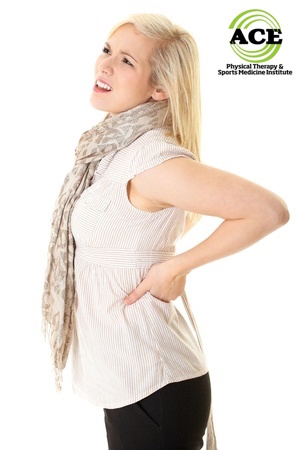LUMBAR TRACTION

Tid Bits of Info
- Many insurance companies do not reimburse for the use of lumbar traction.
- Numerous recent studies have indicated that traction as a sole modality choice is less effective than more active treatment protocols.
- Therapists who use lumbar traction start the treatment with half of the patient’s body weight and progress the pull as tolerated.
- Seek the advice of a Physical Therapist if you have low back pain and they can educate you on the proper treatment for your condition.
For many years, lumbar traction was used to treat low back pain, but in the past decade Physical Therapists have begun using more promising research-based protocols. Lumbar traction seeks to relieve lumbar spinal pressure by stretching soft tissue and creating a “suction” force mechanically. Empirical based results have been the reason some clinicians have continued to use traction though evidence-based studies have not supported the theory.
The lumbar spine consists of 5 vertebra that are positioned in a “C” shape curve. These 5 bones are separated by shock absorbing discs that have a hard outer shell (annulus) and a gel like inside (nucleus pulposus). These discs are extremely durable, but they can suffer damage. As we age or if the sheer or compressive force is too great, the outer shell can crack or rupture. The function of the disc is lost if it “ruptures” and the outer wall or Annulus tears. The tearing of the Annulus enables the inner material, nucleus pulposus, to escape and put pressure on a nerve root at the level of the damage.
In the past, therapists used lumbar traction to reduce this pressure on the nerve and thereby reduce low back pain. Lumbar traction is supposed to increase intervertebral space, the tension on the posterior spinal ligament which places more force on the back of the joints and produce a suction force that can draw a protrusion (disc material) back into the center of the disc. This is based on the theory that the “pull” of the lumbar traction is able to separate the vertebra sufficiently to increase the size of the foramina (nerve root exits through the foramina) and remove the pressure on the root. The deep paraspinal musculature is thought to relax via a stretch/relax reflex secondary to a prolonged stretch produced by the lumbar traction device.
While the theory may be good, it has not been confirmed in actual research. In many studies the separation of the vertebra does not occur. As a result, Physical Therapists have been less likely to use this treatment. In fact, many insurance companies will not pay for it due to the lack of scientific evidence that supports its use. Folks who continue to use lumbar traction rely heavily on empirical results of their previous treatments to fortify their support of its use in their practice.
Over the past decade, Physical Therapists have shifted from the passive treatment of lumbar traction to a regimen of manual techniques and therapeutic exercises that are supported by empirical results and scientific evidence. The lumbar spine paraspinal musculature must be active to support and stabilize the joints of the lumbar spine. The use of manual techniques and specific exercises geared towards re-establishing the normal neuromuscular activity, strength and motion of the spine have been proven to be very successful. The results of this newer approach are promising for most patients who suffer from low back pain with or without referred symptoms into their legs.
Lumbar traction was the treatment of choice for many years for people who suffered from low back pain. The transition to a more active and aggressive treatment protocol can be attributed to the need to “prove” the efficacy of all treatment protocols. When a procedure is not supported by medical science, the use of that procedure slowly dissipates and eventually is no longer considered a viable option in the standard treatment protocols used by most healthcare professionals. Lumbar traction appears to be a procedure that has slowly and steadily lost its appeal in many Physical therapy settings.


























Lumbar Traction Weight Guidelines
The lumbar traction article was very informational and provided my patient’s with great details about what to expect when receiving lumbar traction. It also provided me with some information about the efficacy of lumbar traction and its benefits.